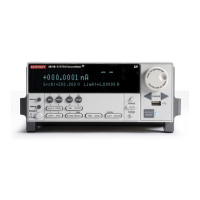8-24 Return to Section Topics 2600S-901-01 Rev. C / January 2008
Section 8: Source-Measure Concepts Series 2600 System SourceMeter® Instruments Reference Manual
increasing the delay factor to 1.3 will account for settling to 0.01% of the final value. The
commands to manipulate the delay factor and analog filter are shown below:
For controlling settling time
smuX.measure.delay = 0 -- to turn off measure delay
(default setting is smuX.DELAY_AUTO)
smuX.measure.delay = Y -- set measure delay for all ranges to Y (in seconds)
smuX.measure.delayfactor = 1.0 --To adjust the delays factor:
This factor is used to multiply the default delays. Setting this value above 1.0 increases the delays,
while a value below 1.0 decreases the delay. Setting this value to 0.0 essentially turns off
measurement delays. This attribute is only used when:
smuX.measure.delay = smuX.DELAY_AUTO.
For analog filter
smuX.measure.analogfilter = 1 (default)
This filter is only active when the amps measure range is 1na/100pA. Setting the attribute to zero
disables the filter.
Reduction in gain-bandwidth
The settling time of the SMU can be influenced by the impedance of the DUT in several ways. One
influence is caused by an interaction between the impedances of the SMU current source
feedback element and the DUT. This interaction can cause a reduction in gain-bandwidth. When
the SMU gain-bandwidth is reduced, the settling time of the current source increases.
The settling times listed in the specifications found in Appendix A assume that the gain-bandwidth
of the SMU is approximately 60kHz. Table 8-5 below can be used to determine the affect of
various DUT impedances on the gain-bandwidth when the SMU is operating on each current
source range. If the ratio of DUT impedance to current source feedback impedance drops below
the indicated 60kHz ratio, then the settling time will increase beyond the specified times.
Therefore, there is a minimum DUT impedance for each current source range. The settling time on
a current range can increase significantly when measuring DUTs that have an impedance that is
lower than that listed in
Table 8-5 below.
Table 8-5
Current source gain-bandwidth
Range
SMU feedback
impedance
60kHz ratio
(DUT / SMU impedance)
Minimum DUT
impedance
1nA 1GΩ 0.5 2GΩ
10nA 120MΩ 0.5 60MΩ
100nA 40MΩ 0.5 20MΩ
1μA 1.2MΩ 0.5 600kΩ
10μA 400kΩ 0.5 200kΩ
100μA 12kΩ 0.5 6kΩ
1mA 4kΩ 0.5 2kΩ
10mA 120Ω 0.5 60Ω
100mA 40Ω 0.5 20Ω
1A 1Ω 6 6Ω
1.5A 1Ω 6 6Ω
3A 0.3Ω 5 1.5Ω

